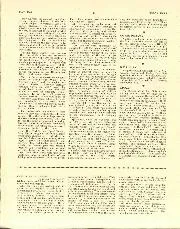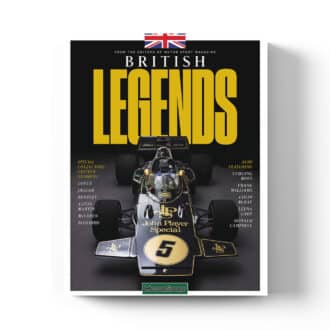
COVER PICTURE
COVER PICTURE Another Donington scene appears on the front cover this month, the cars on the line being an M.G., Dixon's Riley (4) and the late Pat Fairfield's E.R.A. (7).…
MOTORING A L’AMERICAINE THE EIGHT-CYLINDER HUPMOBLLE ROAD-TESTED.
DE$PITE the reduction of the horsepower tax which comes into force next January, English manufacturers show little inclination to put on the market large engined cars of moderate price ; and to obtain a car of this type, a purchaser must turn to transatlantic products. The Motor-car in America is regarded simply in terms of its functional qualities, its ability to bring the driver and his passengers quickly and effortlessly from one place to another, and with so pmeh power to play with, American engineers have been able to combine refinement, performance and speed to an unusual degree, and the increasing number of these vehicles to be seen on English roads shows that their qualities are also appreciated over here.
London traffic conditions cannot hope to daunt an American car, and one is bound to pay tribute to the slickness and ease of control of the Hupmobile under such circumstances. A smooth clutch and a fine flow of power do the trick ; with Just a touch in the gears, and rather surprisingly the six-seater ” Aerodynamic” body did not feel clumsy under these conditions, since the overall width of the mudguards is no greater than on a car with harrow high bonnet and front seats of the usual width. Gaining the Kingston By Pass and the Portsmouth Road, the car really got Into its stride and reached 60 and 65 m.p.h. with effortless acceleration wherever opportunities allowed, most of this being done on top, as the limit in second was about 45 m.p.h. The miles of concrete highways which traverse the American continent call for high cruising Speeds, and on English roads of the same character the speedometer could be kept continually on the ” 80″ mark, representing a speed of just over 70 m.p.h. Engine noise is nothing more than a hum, and the smooth shape of the outside of the body allows it to pass through the air Without whistle or roar, the only complaint being that the driving compartment becomes rather warm, possibly owing to the forward position of the silencer, or
more likely through badly-fitting floorboards. Strangely enough the engine ran if anything rather too cold. On normal give-and-take roads, however, the speed drops considerably, and 55 mph. is about the usual mark. The
Sidesway Eliminator, a torsion-bar device which steadies the back axle, prevents actual roll, but the preliminary movement of the flexible springs makes the driver less enthusiastic on corners than On a car with the English type of springing. Friction type shock absorbers would probably be an improvement, for the car is actually perfectly stable, and if no notice is taken of the slight heel, it can be taken round bends at speeds up to the point when the tyres begin screaming. On fast corners the driver misses the support which a bucket seat affords, and a centre arm-rest would be welcome.
The steering is low-geared, needing over five turns from lock to lock, but this advantage is to a great extent off-set by. a strong castor -action, which spins the wheel back to central position after a turn. The steering lock is a good one, and in spite of the large tyres and unbalanced wheels the car is perfectly happy at all speeds. The brakes were relia.ble, though they called for considerable force to produce full effect, and brought the car to rest, with the rear wheels tending to lock, in 65 feet from 40 m.p.h. In driving the car fast over difficult roads, therefore, one can either hold it into the turn, aeroplane fashion, or take off the foot momentarily while rounding the curve, and rely On the acceleration to get on the move again rapidly, the latter method being the one intended by the makers. Under these conditions the power-plant does its work smoothly and efficiently, and the big six-seater saloon moves from place quickly and with the minimum: of effort. One hardly realises the size and pulling power of the engine until the Flupmobile is baulked on a mainroad hill, when it will glide up Silently at 25 to .30 without calling for a change of gear, ready to surge ahead when a gap occurs in the traffic. During our test in the Downs, the car was often faced with sudden and sharp rises of perhaps 1 in 10, but steepness of gradient hardly ever called for a change down, and when one knows that the car is intended to give such service one cannot help feeling a
satisfaction in experiencing such effortless motoring. As will appear from the foregoing, the gears are seldom used, but when required permit about 25 m.p.h. on bottom and 45 on second. Second gear is
45 on second. gear as quiet as top, and these two gears are fitted with synchromesh mechanism. There is a fairly big gap between second and top, and a pause is needed to allow the pinions to speed up or down, but thanks to the stiff gear-lever the change can be made almost instantly when one is in a hurry. The maximum speed, incidentally, timed over a flying half-mile at Brooklands, worked out at 75 m.p.h., and it is interesting to note that using the old Double Twelve Circuit and coming on to the banking at 35 m.p.h. the car reached 70 M.p.h. at the end of the Railway Straight. The maximum was rather disappointing as the average 8cylinder Hupm.obile will exceed 80 m.p.h., and we attributed the deficit to the engine runMg too cold. . The driving position was well thought out, with the large steering wheel comfortably within reach, and the only fault we could find was that the forward quarter of the
roof, which tapers down to join the front door pillars, form a blind spot for a tall driver looking out to his right, but to compensate for this the pillars at each end of the windscreen are unusually thin. The instruments are grouped in front of the driver, and a switch which incorporates a resistance allows the indirect lighting to be dimmed according to the driver’s wishes; A Philco wireless set is fitted as standard equipment. The headlights give the fan-shaped spread of light usual on American cars, and the right hand one may be dipped by operating a foot-switch. Unfortunately they are rather feeble, and one’s speed at
night is limited to about 50 m.p.h.
The engine is a typical American unit, with eight cylinders in line; side valves, a down-draft carburettor and coil ignition. An engine-driven petrol pump supplies fuel from a 19-gallon rear tank, and the engine runs without pinking on No. 3 or commercial spirit. This is an important consideration in England, for on fast runs with some use of the gears, the petrol consumption may drop as low as 10 m.p.g.
Balanced aluminium alloy pistons are used. The big-ends and main bearings are of courie plain, and the four-bearings crank-shaft is fitted with balance weights and a vibration-damper. Oil is forced to 34 points in the engine, and an
external oil filter is used.
The engine and gear-box unit is carried on rubber mountings at four points, which are arranged so that the insulating material takes its load at shear, and except for the usual wobble at low ticking-over speeds, the mountings completely isolate the chassis from vibration. The clutch has a spring-centre to cushion the drive ; the gearbox is fitted with synchromesh for second and top gears, while hypoid bevel gearing is used in the back-axle and keeps the propeller shaft at a low level. Nickel molybdenum steel is used for the bevel gears, and this material and other highduty alloys are extensively used in the chassis in positions of special stress. The front axle is of hollow tubular construction, and it is interesting to n,pte that the Hupp Corporation have not found it necessary to change over to independent springing, getting their riding comfort
instead through the use of very long semielliptic springs. The frame is swept over the back and front axles braced in the centre with an X member, and is drilled to reduce surplus weight. An interesting feature is the system of bracing rods which unites the front of the frame to the dashboard, which forms part of the chassis structure. The engine is mounted forward over the front axle so that all the passengers are carried within the wheelbase.
Opinions may differ about the frontal appearance of the car, with its oval headlamps carried in fairings, but certainly the sloping rear elevation is pleasing. The rear wheel is sunk into a hinged rear panel giving access to the luggage boot. The doors are exceptionally wide, the seats, which are covered with some velvet material, are each wide enough to take three people, and thanks to the hypoidbevel back axle there is no shaft tunnel to obstruct the centre passenger. An important point to the owner-driver is that the Aerodynamic body does not interfere with the accessibility of the engine, since the bonnet lifts up in the usual way, and is held open by a springloaded prop.
It is early yet to say whether the socalled ” streamline” bodies will be the fashion all over the world in a few years’ time, but the Hupmobile forms an interesting interpretation of the movement which is sweeping America at the present moment. The chassis is typical of the high-class car of that country, and we are indebted to International Distributors, Ltd., of 12 Halkin Street, London, S.W. 1, who are the sole concessionaires for Huoxiobile cars in this country, for this opportunity of recording our impression.



